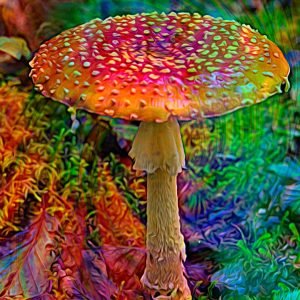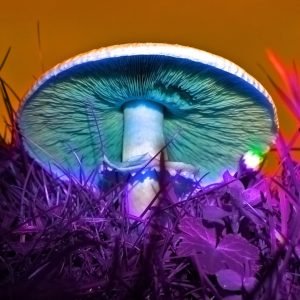Spore tubes are used to grow mushrooms in the field of mycology, which is the study of fungi. They have spores, which are the cells that fungi use to reproduce. To start growing mushrooms, you can use these spores to inoculate a growth medium, which is usually a base like agar or grain.
Here is a general description of how spore syringes are used to grow mushrooms:
Spores are made by mushrooms as part of their process of reproduction. These spores are taken from mature mushrooms in a number of ways, such as by letting the cap of a mature mushroom fall onto a clean surface, where the spores will land.
Sterile Method: Since growing mushrooms involves working with germs, it is important to keep the environment sterile so that unwanted fungi or bacteria don’t get in. The whole process of making spore syringes should be done in a clean, safe place. A laminar flow hood or a still air box are often used for this.
Preparing the Syringe: To make a spore syringe, a clean liquid solution, usually sterile distilled water with a small amount of nutrients, is injected into the cap or spore print of a mature mushroom. This liquid helps the germs stay in the same place.
Spore Suspension: The liquid in the syringe is used to get the spores off the cap or spore print of the mushroom. The spore solution that is made is a mix of water and spores.
A spore needle is used to put spores into a growth medium. This could be a petri dish with agar (for isolating and spreading specific strains) or a medium like sterilized grain or sawdust (for growing mushrooms in large quantities). When the spores land on the medium, they start to grow into mycelium, which is like roots for fungi.
Colonization: Over time, the mycelium spreads out and takes over the growing medium. Most of the time, this process involves incubation at a fixed temperature and level of humidity.
Fruiting: Once the mycelium has completely taken over the ground, the conditions are changed to make mushrooms grow. This means making sure the environment has the right temperature, humidity, and sometimes light. Mushroom pins will grow into full-grown mushrooms in the end.
It’s important to remember that using spore syringes and growing mushrooms take a good understanding of sterile techniques, the right tools, and the specific needs of the mushroom species you are working with. Also, laws and rules about growing certain types of mushrooms and having spores vary from place to place, so it’s important to do study and know what the law is in your area.
CLUMPS IN THE SPORE TUBE
Spore syringe clumping is when spores inside a spore syringe group together or make clusters instead of being spread out evenly in a liquid medium. This can happen for many different reasons, and it could affect how well inoculating a growth medium for growing mushrooms works. Here are some possible reasons why the spores in a syringe might stick together:
Spore Aggregation: Some types of mushrooms have seeds that tend to stick together on their own. This can happen because of how the germs themselves are made.
Not enough shaking: When making the spore syringe, clumps of spores can form if the spore print or cap is not shaken or mixed well enough with the liquid medium. To make sure everything is spread out evenly, you need to stir and mix it the right way.
Contamination: The clumping can be caused by things that get into the spore solution. For example, if there are particles or bacteria in the liquid, they can stick to the spores and make them bunch up.
Incorrect Sterilization: Contamination can happen if the syringe, water, or other parts of the process are not properly sanitized. Spores can get stuck together when contaminants stop them from spreading.
Use of a Thick Solution: If the solution in the syringe is too thick, it can cause the germs to settle or stick together. This can be avoided by using a fluid that is thinner and less concentrated.
Storage Conditions: If the spore syringe is not kept correctly, the spores may settle at the bottom of the syringe, causing them to stick together. Keeping needles standing up and at the right temperature can help with this.
Consider taking the following steps to stop or fix spore syringes from getting clumpy:
Proper Mixing: Make sure to mix the spore solution well so that the spores are properly spread throughout the liquid.
Sterile Methods: Keep things clean and sterile throughout the whole process to avoid contamination that could cause sticking.
Thin Solution: Use a solution that has been dampened enough to keep it from being too thick, which can cause spores to settle or stick together.
Quality Spore Prints: Start with a high-quality spore print that is clean and doesn’t have any spots or other unwanted things on it. Follow the print to make the spore solution right.
Storage: Store spore needles standing up in a cool, dark place to keep the spores from falling to the bottom.
If your spore syringe is getting clumpy, you should check the syringe and the solution carefully before trying to use it to inoculate. If the clumping is bad, it might be best to make a new spore syringe from a different source of spores to make sure the injection and growing of mushrooms goes well.
LIQUID CULTURE TUBE WITH SPORES
A spore needle liquid culture, which is also called an LC (Liquid Culture), is a way to grow mycelium from spores or a small piece of mushroom tissue in a liquid medium. This liquid culture can then be used to start growing mushrooms on bigger pieces of material. Liquid cultures are great for quickly growing mycelium before putting it on large substrates. This makes it more likely that the substrates will be colonized quickly and successfully.
Here’s how it usually works to make and use a spore syringe liquid culture:
Prepare the Liquid Culture Medium: To give the mycelium what it needs to grow, a good liquid medium is made. Usually, the medium is full of important nutrients like carbs, proteins, and other vitamins and minerals. Malt extract, potato dextrose broth, and other similar mixtures are often used as liquid growth media.
Sterilize the Medium: To get rid of any rival microorganisms, the liquid medium is sterilized. Most of the time, this is done by cooking under pressure, using an autoclave, or using another way of sterilization.
Inoculate the Liquid Culture: Once the medium has cooled down, a small piece of mycelium or spores are put into the liquid. This could be done by either injecting a small amount of spore solution or putting a piece of agar that has already been colonized into the medium. You can also use a spore needle to put spores into the liquid.
Incubate: The inoculated liquid culture is then kept in a controlled setting at the right temperature. In the wet medium, the mycelium will start to grow and spread.
Expansion and Care: As the mycelium grows, it will spread out and make a network in the liquid culture. Parts of this culture can be moved to new, clean liquid medium every so often to keep the mycelium growing and keep it healthy.
Inoculation: Once the liquid culture has grown a healthy network of mycelium, it can be used to “inoculate” bigger substrates, like sterilized grain or sawdust, to start the process of growing mushrooms.
When you use spore needle liquid cultures, you can work with a smaller amount of starting material, like spores or a small piece of mycelium, which speeds up the colonization process. But it’s important to keep the environment clean throughout the process to stop contamination, since liquid cultures are more likely to get contaminated than solid substrates like agar.
Different techniques can be used for liquid culture, based on the type of mushroom being grown and what the goal is. It is best to use reliable cultivation guides and resources to find directions that are specific to the mushrooms you are growing.
SPORE FREE LIVE MYCELIUM MUSHROOM LIQUID CULTURE SYRINGE
In advanced mushroom farming, a Mushroom Liquid Culture Syringe with Spore-Free Live Mycelium is a specialized tool that is used. This tube has a liquid culture of growing mycelium (the part of the fungus that is alive), but there are no spores in it on purpose. The goal of using a spore-free liquid culture is to get a highly colonized and clean mycelial solution that can be used to inoculate substrates for mushroom growth without the risk of introducing spores and possible contamination.
IN GENERAL, THIS IS HOW IT GOES:
Mycelium Isolation: The first step is to take a healthy, strong culture of mycelium from a fully grown mushroom. Most of the time, a small piece of a colonized agar plate or other substrate is moved to a liquid medium to get this mycelium.
Preparing a liquid culture: Once the mycelium has been separated, it is added to a nutrient-rich liquid medium. The mycelium grows and spreads with the help of this wet medium.
For colonization, the liquid culture is kept at the right temperature so that the mycelium can grow and spread through the medium. This makes a system with a lot of colonies.
Filling the syringe: When the liquid culture has grown enough, it is sucked into a syringe to make a Mushroom Liquid Culture Syringe. During this whole process, the syringe stays clean.
Inoculation: These tubes, which contain live mycelium without spores, can be used to inoculate substrates like sterilized grains or other food sources. When compared to starting with spores, this speeds up the growth process because the mycelium is already there and ready to grow.
Mushroom Fruiting: After putting the mycelium from the liquid culture tube on the substrate, the substrate is left alone so that it can be fully colonized. Once migration is done, the environment is changed to make it easier for mushrooms to grow and form.
When growing mushrooms, there are several benefits to using spore-free mycelium liquid cultures:
Reduced Risk of Contamination: Since there are no germs in the liquid culture, the risk of contamination is reduced. Contaminants can compete with or stop the growth of mushrooms, so working with cultures that don’t have spores increases the chances of growing mushrooms successfully.
Faster Colonization: When you start with established mycelium instead of spores, the colonization process is often faster.
Consistency: Using mycelium from a known strain makes sure that the genes are the same all the way through the growing process.
It’s important to remember that working with spore-free mycelium liquid cultures needs a good understanding of sterile techniques and advanced cultivation practices. Also, getting spore-free mycelium and making these syringes may be harder than working with spore syringes, so it’s best for growers with more experience.




Leave a Reply